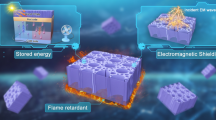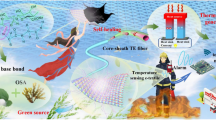Abstract
As a novel energy-harvesting device, a triboelectric nanogenerator (TENG) can harvest almost all mechanical energy and transform it into electrical energy, but its output is low. Although the micro-nano structures of triboelectrode surfaces can improve their output efficiency, they lead to high costs and are not suitable for large-scale applications. To address this problem, we developed a novel TENG coating with charge-storage properties. In this study, we modified an acrylic resin, a friction material, with nano-BaTiO3 particles and gas phase fluorination. The charge-trapping ability of nanoparticles was used to improve the output of TENG. The short-circuit current and the output voltage of coating-based TENGs featuring charge storage and electrification reached 15 µA and 800 V, respectively, without decay for longtime working. On this basis, self-powered anticorrosion and antifouling systems are designed to reduce the open circuit potential of A3 steel by 510 mV and reduce the adhesion rate of algae on the surface of metal materials. This study presents a high-output, stable, coating-based TENG with potential in practical applications for anticorrosion and antifouling.
Similar content being viewed by others
References
Fan F R, Tian Z Q, Wang Z L. Flexible triboelectric generator. Nano Energy, 2012, 1(2): 328–334
Huang L, Xu W, Bai G, et al. Wind energy and blue energy harvesting based on magnetic-assisted noncontact triboelectric nanogenerator. Nano Energy, 2016, 30: 36–42
Wang Y, Yu X, Yin M, et al. Gravity triboelectric nanogenerator for the steady harvesting of natural wind energy. Nano Energy, 2021, 82: 105740
Xia K, Zhu Z, Zhang H, et al. Painting a high-output triboelectric nanogenerator on paper for harvesting energy from human body motion. Nano Energy, 2018, 50: 571–580
Liu Y, Sun G, Liu Y, et al. Hydrophobic organic coating based water-solid TENG for water-flow energy collection and self-powered cathodic protection. Frontiers of Materials Science, 2021, 15(4): 601–610
Feng M, Wu Y, Feng Y, et al. Highly wearable, machine-washable, and self-cleaning fabric-based triboelectric nanogenerator for wireless drowning sensors. Nano Energy, 2022, 93: 106835
Saadatnia Z, Mosanenzadeh S G, Li T, et al. Polyurethane aerogel-based triboelectric nanogenerator for high performance energy harvesting and biomechanical sensing. Nano Energy, 2019, 65: 104019
Zhong W, Xu L, Zhan F, et al. Dripping channel based liquid triboelectric nanogenerators for energy harvesting and sensing. ACS Nano, 2020, 14(8): 10510–10517
Wu J, Zheng Y, Li X. Recent progress in self-powered sensors based on triboelectric nanogenerators. Sensors, 2021, 21(21): 7129
Shang W, Gu G Q, Yang F, et al. A sliding-mode triboelectric nanogenerator with chemical group grated structure by shadow mask reactive ion etching. ACS Nano, 2017, 11(9): 8796–8803
Liu C, Li J, Che L, et al. Toward large-scale fabrication of triboelectric nanogenerator (TENG) with silk-fibroin patches film via spray-coating process. Nano Energy, 2017, 41: 359–366
Xu C, Liu Y, Liu Y, et al. New inorganic coating-based triboelectric nanogenerators with anti-wear and self-healing properties for efficient wave energy harvesting. Applied Materials Today, 2020, 20: 100645
Luo N, Feng Y, Li X, et al. Manipulating electrical properties of silica-based materials via atomic oxygen irradiation. ACS Applied Materials & Interfaces, 2021, 13(13): 15344–15352
Hao Y, Huang J, Liao S, et al. All-electrospun performance-enhanced triboelectric nanogenerator based on the charge-storage process. Journal of Materials Science, 2022, 57(8): 5334–5345
Zhao Z, Dai Y, Liu D, et al. Rationally patterned electrode of direct-current triboelectric nanogenerators for ultrahigh effective surface charge density. Nature Communications, 2020, 11(1): 6186
Zhou L, Liu D, Zhao Z, et al. Simultaneously enhancing power density and durability of sliding-mode triboelectric nanogenerator via interface liquid lubrication. Advanced Energy Materials, 2020, 10(45): 2002920
Hwang H J, Hong H, Cho B G, et al. Band well structure with localized states for enhanced charge accumulation on triboelectrification. Nano Energy, 2021, 90: 106647
Jiang H, Lei H, Wen Z, et al. Charge-trapping-blocking layer for enhanced triboelectric nanogenerators. Nano Energy, 2020, 75: 105011
Kong X, Liu Y, Liu Y, et al. New coating TENG with antiwear and healing functions for energy harvesting. ACS Applied Materials & Interfaces, 2020, 12(8): 9387–9394
Sun W, Luo N, Liu Y, et al. A new self-healing triboelectric nanogenerator based on polyurethane coating and its application for self-powered cathodic protection. ACS Applied Materials & Interfaces, 2022, 14(8): 10498–10507
Feng Y, Zheng Y, Zhang G, et al. A new protocol toward high output TENG with polyimide as charge storage layer. Nano Energy, 2017, 38: 467
Lai M, Du B, Guo H, et al. Enhancing the output charge density of TENG via building longitudinal paths of electrostatic charges in the contacting layers. ACS Applied Materials & Interfaces, 2018, 10(2): 2158–2165
Ali D, Yu B, Duan X, et al. Enhancement of output performance through post-poling technique on BaTiO3/PDMS-based triboelectric nanogenerator. Nanotechnology, 2017, 28(7): 075203
Feng S, Zhang H, He D, et al. Synergistic effects of BaTiO3/multiwall carbon nanotube as fillers on the electrical performance of triboelectric nanogenerator based on polydimethylsiloxane composite films. Energy Technology, 2019, 7(6): 1900101
Kang X, Pan C, Chen Y, et al. Boosting performances of triboelectric nanogenerators by optimizing dielectric properties and thickness of electrification layer. RSC Advances, 2020, 10(30): 17752–17759
Li Z, Wang X, Hu Y, et al. Triboelectric properties of BaTiO3/polyimide nanocomposite film. Applied Surface Science, 2022, 572: 151391
Liu X, Zhao K, Yang Y. Effective polarization of ferroelectric materials by using a triboelectric nanogenerator to scavenge wind energy. Nano Energy, 2018, 53: 622–629
Chen J, Guo H, He X, et al. Enhancing performance of triboelectric nanogenerator by filling high dielectric nanoparticles into sponge PDMS film. ACS Applied Materials & Interfaces, 2016, 8(1): 736–744
M M, Rajagopalan P, Xu S, et al. Enhancement of patterned triboelectric output performance by an interfacial polymer layer for energy harvesting application. Nanoscale, 2021, 13(48): 20615–20624
Wang N, Liu Y, Wu Y, et al. A β-cyclodextrin enhanced polyethylene terephthalate film with improved contact charging ability in a high humidity environment. Nanoscale Advances, 2021, 3(21): 6063–6073
Chun J, Kim J W, Jung W, et al. Mesoporous pores impregnated with au nanoparticles as effective dielectrics for enhancing triboelectric nanogenerator performance in harsh environments. Energy & Environmental Science, 2015, 8(10): 3006–3012
Pu J, Wang X, Xu R, et al. Highly stretchable microsupercapacitor arrays with honeycomb structures for integrated wearable electronic systems. ACS Nano, 2016, 10(10): 9306–9315
Shi K, Zou H, Sun B, et al. Dielectric modulated cellulose paper/PDMS-based triboelectric nanogenerators for wireless transmission and electropolymerization applications. Advanced Functional Materials, 2020, 30(4): 1904536
Xiao S, Jiang W. Preparation and characterization of barium strontium titanate/silicon nanoporous pillar array composite thin films by a sol-gel method. International Journal of Minerals Metallurgy and Materials, 2012, 19(8): 762–767
Feng Y, Zheng Y, Rahman Z U, et al. Paper-based triboelectric nanogenerators and their application in self-powered anticorrosion and antifouling. Journal of Materials Chemistry A: Materials for Energy and Sustainability, 2016, 4(46): 18022–18030
Wang Z, Cheng L, Zheng Y B, et al. Enhancing the performance of triboelectric nanogenerator through prior-charge injection and its application on self-powered anticorrosion. Nano Energy, 2014, 10: 37–43
Zhang Y, Wu J, Cui S, et al. Organosulfonate counteranions — a trapped coordination polymer as a high-output triboelectric nanogenerator material for self-powered anticorrosion. Chemistry, 2020, 26(3): 584–591
Zhang G, Li B, Liu J, et al. The bacterial community significantly promotes cast iron corrosion in reclaimed wastewater distribution systems. Microbiome, 2018, 6(1): 222
Teng F, Guan Y T, Zhu W P. Effect of biofilm on cast iron pipe corrosion in drinking water distribution system: corrosion scales characterization and microbial community structure investigation. Corrosion Science, 2008, 50(10): 2816–2823
Gudipati C S, Finlay J A, Callow J A, et al. The antifouling and fouling-release performance of hyperbranched fluoropolymer (HBFP)-poly(ethylene glycol) (PEG) composite coatings evaluated by adsorption of biomacromolecules and the green fouling alga Ulva. Langmuir, 2005, 21(7): 3044–3053
Pérez-Roa R E, Anderson M A, Rittschof D, et al. Inhibition of barnacle (Amphibalanus amphitrite) cyprid settlement by means of localized, pulsed electric fields. Biofouling, 2008, 24(3): 177–184
Banerjee I, Pangule R C, Kane R S. Antifouling coatings: recent developments in the design of surfaces that prevent fouling by proteins, bacteria, and marine organisms. Advanced Materials, 2011, 23(6): 690–718
Yebra D M, Kiil S, Dam-Johansen K. Antifouling technology — past, present and future steps towards efficient and environmentally friendly antifouling coatings. Progress in Organic Coatings, 2004, 50(2): 75–104
Amr A G, Schoenbach K H. Biofouling prevention with pulsed electric fields. IEEE Transactions on Plasma Science, 2000, 28(1): 115–121
Acknowledgements
Thanks for the financial support of the Program for Taishan Scholars of Shandong Province (Grant No. ts20190965), the National Natural Science Foundation of China (Grant Nos. U21A2046 and U2106226), the Key Research Program of the Chinese Academy of Sciences (Grant No. ZDBS-ZRKJZ-TLC010), the Western Light Project of CAS (Grant No. xbzg-zdsys-202118), the Major Program of the Lanzhou Institute of Chemical Physics, CAS (Grant No. ZYFZFX-5), and the Shandong Natural Science Foundation (Grant No. ZR202102230178) in China.
Author information
Authors and Affiliations
Corresponding authors
Electronic Supplementary Material
11706_2023_635_MOESM1_ESM.pdf
Charge storage coating based triboelectric nanogenerator and its applications in self-powered anticorrosion and antifouling
Rights and permissions
About this article
Cite this article
Zhang, Z., Liu, Y., Feng, M. et al. Charge storage coating based triboelectric nanogenerator and its applications in self-powered anticorrosion and antifouling. Front. Mater. Sci. 17, 230635 (2023). https://doi.org/10.1007/s11706-023-0635-y
Received:
Accepted:
Published:
DOI: https://doi.org/10.1007/s11706-023-0635-y




